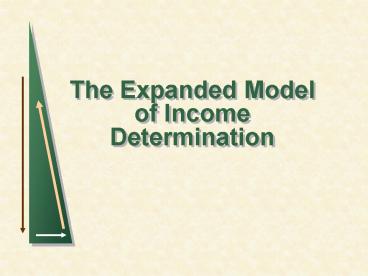The Expanded Model of Income Determination PowerPoint PPT Presentation
1 / 36
Title: The Expanded Model of Income Determination
1
- The Expanded Model of Income Determination
2
Expanded model of income determination
- In chapter 14, a very basic Keynesian model of
income determination was introduced - This model serves as an introduction to income
determination and capacity utilisation in the
economy - If is far to simple to be of any use in the real
world, but it establishes some important points
nevertheless
3
Keynes, John Maynard, 1st Baron Keynes of Tilton
(1883-1946)
4
Expanded model of income determination
- Recall when Keynes was writing mid thirties
with massive unemployment - Established theory until then had assumed that
this would be a temporary phenomenon - In a world with flexible prices, in the long run
equilibrium will exist in all markets - Keynes In the long run, we are all dead
5
Expanded model of income determination
- Keynes gave politicians theoretically sound
arguments for intervening in the economy - Keynes in particular focused on how the
authorities could affect aggregate demand through
fiscal policy, i.e. government purchases of goods
and services and taxes - In chapter 15, this is incorporated into the
basic model of income determination.
6
Expanded Model of Income Determination
- We introduce a public sector, with government
purchases of goods and services G and taxes T.
This model could be labelled a Keynes model for a
closed economy with a public sector - Later in the chapter, another sector is
introduced the foreign sector. Only goods
transactions takes place, exports (X) and imports
(Z) - This chapter also provides a more satisfactory
explanation of investment demand
7
Investment demand
- Demand for investment goods (I) very much depends
on the outlook for the economy - Profitability depends on
- Investment outlay
- Increased income due to the investment
- Costs of financing the investment
- Increased income cost of investment
MEI(marginal efficiency of investment) - Cost of financing R
8
Time value of money
- The investment outlay is paid for today
- Income will accrue in the future, and value may
be reduced due to - impatience and postponement of demand
- risk
- inflation
- Income must be discounted by an interest rate R
9
Net Present Value
- Example
- Investment outlay 10 000
- Income year 1 6 000
- Income year 2 2 6 000
- Interest rate (R) 5 (0,05)
- What is the PV of the income?
10
Marginal Efficiency of Investment (MEI)
Rate of return (R)
Marginal efficiency of investment
R2
R1
I0
I2
I1
11
Expectations change
Rate of return (R)
Marginal efficiency of investment
R0
I2
I0
I1
12
Keynesian business cycle
- The accelerator
- changes in national income and induced investment
- the accelerator coefficient
- the instability of investment
- The multiplier / accelerator interaction
13
Fluctuations in UK real GDP and investment
1978-2002
14
Fluctuations in UK real GDP and investment
1978-2002
GDP
15
Fluctuations in UK real GDP and investment
1978-2002
Investment
GDP
16
Accelerator 1970-1999 in Norway
17
Accelerator theorycapital output ratio 2
18
Accelerator theory
- Investments are dependent on expected changes in
GDP or I ? ?Y - Accelerator a small change in income gives a
large change in induced investment - This depends on the marginal ratio between
capital and production - In addition, we will have multiplier effects
between I and Y
19
Introducing the public sector
- Taxes T represent a withdrawal from the economic
circulation (like savings S) - The Governments demand for goods and services G
represent an injection (like investments I) - Equilibrium when realised withdrawals realised
injections - S T I G
20
Keynes expanded model - 1
- The public sectors demand for goods and services
G is always exogenousTaxes (T) - Version 1 Lump sum taxes T T
- Version 2 Income taxes T tY, where t is the
(average) tax rate
21
The model version 1
22
Equilibrium
23
An example
- Assume we have the following
- C 0,8Yd
- I 60
- G 50
- T 50
24
The multipliers
25
The model
26
Haavelmos theorem
- What happens if an increase in public spending is
financed by an equivalent tax increase, i.e. ?G
?T?
27
The Model Version 2
28
Equilibrium
29
The multipliers
30
The model
31
Built in stabilisers
Government expenditure and Taxes
T
G
G
T
Yb
32
Introducing the foreign sector
- Imports Z and Exports X
- Equilibrium when leakages injectionsS T Z
I G X - It is assumed that imports are endogenous and
dependent on income - Exports are exogenous
33
Economic circulation
34
The model
35
The multipliers
36
The open economy model

